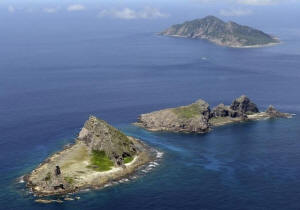|
Japan protests after Chinese warship
sails near disputed East China Sea islands
 Send a link to a friend
Send a link to a friend
 [June 09, 2016]
TOKYO (Reuters) - Japan summoned the
Chinese ambassador early on Thursday to express concern after a Chinese
navy ship sailed close to what Japan considers its territorial waters in
the East China Sea for the first time, increasing tensions over the
disputed area. [June 09, 2016]
TOKYO (Reuters) - Japan summoned the
Chinese ambassador early on Thursday to express concern after a Chinese
navy ship sailed close to what Japan considers its territorial waters in
the East China Sea for the first time, increasing tensions over the
disputed area.
Japan said a Chinese frigate sailed within 24 miles (38 kms) of
the contested territory, the islands known as the Senkaku in Japan
and the Diaoyu in China, shortly after midnight.
Japan's Vice Foreign Minister Akitaka Saiki summoned the Chinese
ambassador in Tokyo at around 2 a.m. (01:00 p.m. EDT on Wednesday)
to "express a serious concern," the government said in a statement.
Japanese and Chinese coastguard vessels frequently face off around
the islands as both sides press their claims. Until now neither has
dispatched warships to nearby waters, because doing so would inflame
tensions and remove a buffer against potential armed conflict.
"We are worried that this action raises tensions to a higher level,"
Japan's Chief Cabinet Secretary Yoshihide Suga said at a regular
press briefing in Tokyo.
"Related ministries are working together to deal with this and we
will work closely with the U.S.," Suga said.
 China's Defence Ministry said on Thursday it was looking into the
reports that one of its navy ships sailed close to the disputed
islands, adding its navy had every right to operate in Chinese
waters.
"Chinese naval ships sailing through waters our country has
jurisdiction over is reasonable and legal. No other country has the
right to make thoughtless remarks about this," it said in a
statement sent to Reuters.
While the U.S. has not endorsed Tokyo's territorial claim to the
islands, which lie about 220 kms (135 miles) northeast of Taiwan, it
has said the Japanese-controlled territory falls under its security
treaty with Tokyo that obligates Washington to defend Japan against
attack.
"We are aware of the reports and have been in touch with the
Japanese government," U.S. Deputy Assistant Secretary of State for
East Asian and Pacific Affairs, Colin Willett told reporters by
telephone from Washington.
"Until I have a little more detail, I can't really comment on
exactly what (Washington's) reaction is," she added.
The Chinese frigate stayed in the waters around the Senkaku/Diaoyu
waters for about an hour before sailing toward the Chinese coast.
Countries can police their contiguous zone, adjacent to the disputed
territory, for customs and immigration violations, but can't prevent
passage by other nations' vessels.
[to top of second column] |

A group of disputed islands, Uotsuri island (top), Minamikojima
(bottom) and Kitakojima, known as Senkaku in Japan and Diaoyu in
China is seen in the East China Sea, in this photo taken by Kyodo
September 2012. Mandatory credit. REUTERS/Kyodo

Complicating the situation for Tokyo, three Russian naval vessels
also sailed close to the islands at around the same time as the
Chinese warship, raising concern in Japan of a coordinated show of
force by Beijing and Moscow.
Russia and Japan are locked in a separate territorial dispute over
the return of islands seized by Moscow at the end of World War Two.
Suga said the government was investigating to uncover any link
between the movements of Chinese and Russian vessels.
The incidents come as Japan, the United States and India prepare to
begin a major joint naval exercise, dubbed Malabar,
from Friday in the nearby Western Pacific.
As China pushes its claims in the neighboring South China Sea, which
Japanese Minister of Defence Gen Nakatani described last week as
"unilateral and coercive," Tokyo and Washington are worried Beijing
will look to extend its influence into the East China Sea and
beyond.
Japan's island chain there, including Okinawa which hosts the
biggest concentration of U.S. military personnel in Asia, stands in
the way of unfettered access to those seas. Japan's military is
reinforcing the islands with radar stations and anti-ship missile
batteries.
(Reporting by Tetsushi Kajimoto and Nobuhiro Kubo in TOKYO, Ben
Blanchard in BEIJING and Matt Siegel in SYDNEY; Writing by Tim
Kelly; Editing by Paul Tait and Michael Perry)
[© 2016 Thomson Reuters. All rights
reserved.]
Copyright 2016 Reuters. All rights reserved. This material may not be published,
broadcast, rewritten or redistributed.
 |